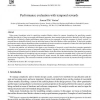99 search results - page 9 / 20 » The Complexity of Quantitative Information Flow Problems |
NN
2006
Springer
13 years 6 months ago
2006
Springer
How does attention operate in natural scenes? We show that the receptive fields of inferior temporal cortex neurons that implement object representations become small and located ...
PE
2002
Springer
13 years 6 months ago
2002
Springer
Today many formalisms exist for specifying complex Markov chains. In contrast, formalisms for specifying rewards, enabling the analysis of long-run average performance properties,...
JUCS
2007
13 years 6 months ago
2007
: Motion estimation from image sequences is a complex problem which requires high computing resources and is highly affected by changes in the illumination conditions in most of th...
SOCIALCOM
2010
13 years 4 months ago
2010
Abstract--In both the commercial and defense sectors a compelling need is emerging for rapid, yet secure, dissemination of information. In this paper we address the threat of infor...
COGSCI
2010
13 years 6 months ago
2010
With only two to five slots of visual working memory (VWM), humans are able to quickly solve complex visual problems to near optimal solutions. To explain the paradox between tigh...

